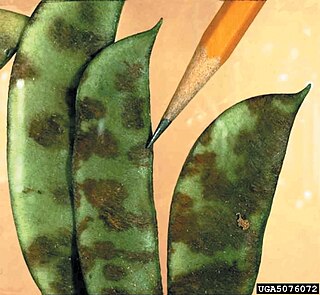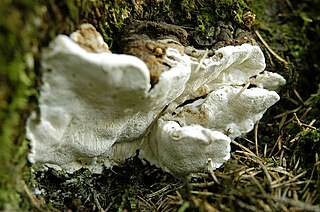
Yeasts are eukaryotic, single-celled microorganisms classified as members of the fungus kingdom. The first yeast originated hundreds of millions of years ago, and at least 1,500 species are currently recognized. They are estimated to constitute 1% of all described fungal species.

Saccharomyces cerevisiae is a species of yeast. The species has been instrumental in winemaking, baking, and brewing since ancient times. It is believed to have been originally isolated from the skin of grapes. It is one of the most intensively studied eukaryotic model organisms in molecular and cell biology, much like Escherichia coli as the model bacterium. It is the microorganism behind the most common type of fermentation. S. cerevisiae cells are round to ovoid, 5–10 μm in diameter. It reproduces by budding.

Schizosaccharomyces pombe, also called "fission yeast", is a species of yeast used in traditional brewing and as a model organism in molecular and cell biology. It is a unicellular eukaryote, whose cells are rod-shaped. Cells typically measure 3 to 4 micrometres in diameter and 7 to 14 micrometres in length. Its genome, which is approximately 14.1 million base pairs, is estimated to contain 4,970 protein-coding genes and at least 450 non-coding RNAs.

Cryptococcus is a genus of fungi in the family Cryptococcaceae that includes both yeasts and filamentous species. The filamentous, sexual forms or teleomorphs were formerly classified in the genus Filobasidiella, while Cryptococcus was reserved for the yeasts. Most yeast species formerly referred to Cryptococcus have now been placed in different genera. The name Cryptococcus comes from the Greek for "hidden sphere". Some Cryptococcus species cause a disease called cryptococcosis.
Heterothallic species have sexes that reside in different individuals. The term is applied particularly to distinguish heterothallic fungi, which require two compatible partners to produce sexual spores, from homothallic ones, which are capable of sexual reproduction from a single organism.

Komagataella is a methylotrophic yeast within the order Saccharomycetales. It was found in the 1960s as Pichia pastoris, with its feature of using methanol as a source of carbon and energy. In 1995, P. pastoris was reassigned into the sole representative of genus Komagataella, becoming Komagataella pastoris. Later studies have further distinguished new species in this genus, resulting in a total of 7 recognized species. It is not uncommon to see the old name still in use in the context of protein production, as of 2023; in less formal use, the yeast may confusingly be referred to as pichia.

Fungi are a diverse group of organisms that employ a huge variety of reproductive strategies, ranging from fully asexual to almost exclusively sexual species. Most species can reproduce both sexually and asexually, alternating between haploid and diploid forms. This contrasts with most multicellular eukaryotes such as mammals, where the adults are usually diploid and produce haploid gametes which combine to form the next generation. In fungi, both haploid and diploid forms can reproduce – haploid individuals can undergo asexual reproduction while diploid forms can produce gametes that combine to give rise to the next generation.
Saccharomyces pastorianus is a yeast used industrially for the production of lager beer, and was named in honour of Louis Pasteur by the German Max Reess in 1870. This yeast's complicated genome appears to be the result of hybridisation between two pure species in the Saccharomyces species complex, a factor that led to difficulty in establishing a proper taxonomy of the species.
Saccharomyces bayanus is a yeast of the genus Saccharomyces, and is used in winemaking and cider fermentation, and to make distilled beverages. Saccharomyces bayanus, like Saccharomyces pastorianus, is now accepted to be the result of multiple hybridisation events between three pure species, Saccharomyces uvarum, Saccharomyces cerevisiae and Saccharomyces eubayanus. Notably, most commercial yeast cultures sold as pure S. bayanus for wine making, e.g. Lalvin EC-1118 strain, have been found to contain S. cerevisiae cultures instead

Colletotrichum is a genus of fungi that are symbionts to plants as endophytes or phytopathogens. Many of the species in this genus are plant pathogens, but some species may have a mutualistic relationship with hosts.
A killer yeast is a yeast, such as Saccharomyces cerevisiae, which is able to secrete one of a number of toxic proteins which are lethal to susceptible cells. These "killer toxins" are polypeptides that kill sensitive cells of the same or related species, often functioning by creating pores in target cell membranes. These yeast cells are immune to the toxic effects of the protein due to an intrinsic immunity. Killer yeast strains can be a problem in commercial processing because they can kill desirable strains. The killer yeast system was first described in 1963. Study of killer toxins helped to better understand the secretion pathway of yeast, which is similar to those of more complex eukaryotes. It also can be used in treatment of some diseases, mainly those caused by fungi.
Ira Herskowitz was an American phage and yeast geneticist who studied genetic regulatory circuits and mechanisms. He was particularly noted for his work on mating type switching and cellular differentiation, largely using Saccharomyces cerevisiae as a model organism.

Heterobasidion is a genus of basidiomycetes in the family of Bondarzewiaceae. Species in this genus include tree decay fungi that may be pathogenic and cause deterioration of tree health including mortality. Fungi in the genus produce shelf-like polyporous fruiting bodies that release spores from pores. Mating studies in the late twentieth century and genetic studies in the early twenty-first century have led to description of several new species and replacement of some of the original names. As a result, two former Heterobasidion species, H. annosum and H. insulare, are now recognized to each comprise multiple distinct species.
Saccharomyces paradoxus is a wild yeast and the closest known species to the baker's yeast Saccharomyces cerevisiae. It is used in population genomics and phylogenetic studies to compare its wild characteristics to laboratory yeasts.
Saccharomyces eubayanus, a cryotolerant type of yeast, is most likely the parent of the lager brewing yeast, Saccharomyces pastorianus.
Saccharomyces kudriavzevii, is a species of yeast in the Saccharomyces sensu stricto complex. Its type strain is NCYC 2889T. It is used in production of alcoholic beverages, including pinot noir wine, and hybrids of it are used in beer brewing. It is isolated widely from the bark of oak trees.
Saccharomyces cariocanus, a type of yeast in the Saccharomyces sensu stricto complex. Its type strain is NCYC 2890T. Analyses did not confirm the previously observed conspecificity with Saccharomyces paradoxus. S. cariocanus exhibits postzygotic isolation from representative strains from all known geographical populations of S. paradoxus: European, Far-East Asian, North American and Hawaiian.

Bernard Dujon is a French geneticist, born on August 8, 1947, in Meudon (Hauts-de-Seine). He is Professor Emeritus at Sorbonne University and the Institut Pasteur since 2015. He is a member of the French Academy of sciences.
Fungal genomes are among the smallest genomes of eukaryotes. The sizes of fungal genomes range from less than 10 Mbp to hundreds of Mbp. The average genome size is approximately 37 Mbp in Ascomycota, 47 Mbp in Basidiomycota and 75 Mbp in Oomycota. The sizes and gene numbers of the smallest genomes of free-living fungi such as those of Wallemia ichthyophaga, Wallemia mellicola or Malassezia restricta are comparable to bacterial genomes. The genome of the extensively researched yeast Saccharomyces cerevisiae contains approximately 12 Mbp and was the first completely sequenced eukaryotic genome. Due to their compact size fungal genomes can be sequenced with less resources than most other eukaryotic genomes and are thus important models for research. Some fungi exist as stable haploid, diploid, or polyploid cells, others change ploidy in response to environmental conditions and aneuploidy is also observed in novel environments or during periods of stress.








